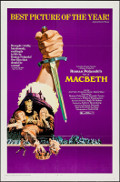
Directed by
Roman Polanski
141 minutes
Rated M
Reviewed by
Chris Thompson

Tragedy Of Macbeth. The
Synopsis: The brave warrior, Macbeth (Jon Finch), receives a prophecy from three witches who tell him he will be King of Scotland. Encouraged by his ambitious wife (Francesca Annis) Macbeth murders King Duncan (Nicholas Selby) and usurps the throne, arousing the suspicions of his rival, Macduff (Terence Baylor), and his once-loyal friend, Banquo (Martin Shaw).With Justin Kurzel’s Macbeth currently screening, it seemed a good time to revisit this earlier version of Shakespeare's Scottish play which had such a great impact on me as a teenager in the 70s. It’s a risky business, going back to an old favourite after forty years but, happily, Polanski’s version stands up well. His is a reasonably traditional interpretation but one accentuating the elements of violence, gore and the sexual undertones that already existed in the play. It’s not surprising when you consider the era in which he made it; the story resonates well with the social and political unrest of the late 60s and has quite palpable echoes of the recent political assassinations of the Kennedy brothers and Martin Luther King.
The other contextual aspect, of course, is that Polanski made Macbeth only a year or so after the horrific murder of his pregnant wife, Sharon Tate, at the hands of the Manson Family. In the scene where Macduff’s wife and children are murdered, there is a moment where Lady Macduff watches on in horror as the barbaric assassins in the next room rape and butcher her female servants. It’s hard not to make the connection.
But, quite apart from its historical context, this is a great work on many filmic levels. It’s beautifully shot in Todd-AO by Gilbert Taylor who evokes a cold and gloomy world with lonely, windswept vistas overlooked by towering stone castles. The soundtrack, too, plays an important role, not just in the terrific music composed by Prog-Rock group, The Third Ear Band, but in the way its sound design accentuates the foreboding elements of the natural world – the animal cries, the distant thunder, the gathering storm - that seem to portend the tragedy that Macbeth is bringing upon himself. For the screenplay, Polanski enlisted the highly renowned theatre critic and writer, Kenneth Tynan as co-writer and together they craft a strong telling of a rich tale that is brought to life by a young but highly skilled cast.
Macbeth was made in the wake of Polanski’s success with Rosemary’s Baby in 1968 and he seems to revel here in another chance to explore the supernatural world, this time through the auspices of the three witches (Maisie MacFarquhar, Elise Taylor and Noelle Rimmington) who are both grotesque and compelling. The scene where Macbeth seeks them out a second time in their cranny on the moor, only to discover the whole coven of naked and misshapen witches gathered around the cauldron casting their “double double toil and trouble” spell is audacious and memorable.
The tragic ending to Macbeth’s tale is well known and often told but Polanski, like Kurzel, takes the opportunity to offer one final imagined scene that reinforces the notion that the bloody lineage of Scottish rule will not end with the death of Macbeth. The final moment in Polanski’s film sees Donalbain (son of the murdered King Duncan) approaching the witches’ cranny in search of a prophecy of his own. In Kurzel’s film, we see Fleance (Banquo’s son) draw Macbeth’s sword from the fallen King’s corpse and walk off towards the castle against a blood red sky, presumably to fulfil the witch’s second prophecy that Banquo’s sons shall be kings.
Whilst, for me, the Polanski film stands as the stronger of the two, it’s Kurzel’s final image that provides the more chilling and satisfying end.

Want more about this film?


Want something different?




